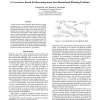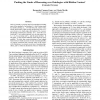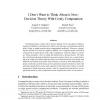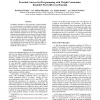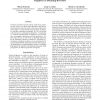KR
2010
Springer
14 years 4 months ago
2010
Springer
Preference logics and AI preference representation languages are both concerned with reasoning about preferences on combinatorial domains, yet so far these two streams of research...
KR
2010
Springer
14 years 4 months ago
2010
Springer
Dynamic epistemic logic deals with the representation of situations in a multi-agent and dynamic setting. It allows to express in a uniform way statements about:
KR
2010
Springer
14 years 4 months ago
2010
Springer
A plan with rich control structures like branches and loops can usually serve as a general solution that solves multiple planning instances in a domain. However, the correctness o...
KR
2010
Springer
14 years 4 months ago
2010
Springer
There is currently a growing interest in techniques for hiding parts of the signature of an ontology Kh that is being reused by another ontology Kv. Towards this goal, Cuenca Grau...
KR
2010
Springer
14 years 4 months ago
2010
Springer
Sequential diagnosis takes measurements of an abnormal system to identify faulty components, where the goal is to reduce the diagnostic cost, defined here as the number of measur...
KR
2010
Springer
14 years 4 months ago
2010
Springer
Computation plays a major role in decision making. Even if an agent is willing to ascribe a probability to all states and a utility to all outcomes, and maximize expected utility,...
KR
2010
Springer
14 years 4 months ago
2010
Springer
Cardinality constraints or, more generally, weight constraints are well recognized as an important extension of answer-set programming. Clearly, all common algorithmic tasks relat...
KR
2010
Springer
14 years 4 months ago
2010
Springer
In discrete dynamical systems change results from actions. As such, given a set of observations, diagnoses often take the form of posited events that result in the observed behavi...
KR
2010
Springer
14 years 4 months ago
2010
Springer
Topological logics are a family of languages for representing and reasoning about topological data. In this paper, we consider propositional topological logics able to express the...
KR
2010
Springer
14 years 4 months ago
2010
Springer
In this paper we present a model for decision making under complete ignorance. By complete ignorance it is meant that all that is known is the set of possible consequences associa...

